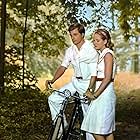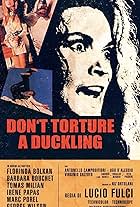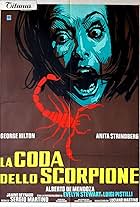IMDb RATING
7.0/10
6.3K
YOUR RATING
Stefano, a young restorer, is commissioned to save a controversial mural located in the church of a small, isolated village.Stefano, a young restorer, is commissioned to save a controversial mural located in the church of a small, isolated village.Stefano, a young restorer, is commissioned to save a controversial mural located in the church of a small, isolated village.
- Awards
- 1 nomination total
Cesare Bastelli
- Car Driver
- (uncredited)
Storyline
Did you know
- TriviaThe house used as the laughing windows one was located in a small village called Malalbergo, close to Bologna. Already at the time of filming the house was crumbling so it was demolished not longer after filming had wrapped. However, for years people believed it still stood and often went looking for it.
- GoofsWhen Stefano leaves Copppola, mid-conversation, to check on Francesca, when he finds her sleeping, he returns momentarily to find Coppola gone without warning or trace. He then goes outside to look for him, and hears the front gate slam, assuming most likely that Coppola had left without saying good-bye. End of scene. Next time Coppola appears, he offers no explanation or apology and Stefano doesn't bring it up.
- ConnectionsFeatured in Fear at 400 Degrees: The Cine-Excess of 'Suspiria' (2009)
Featured review
*Minor plot details, no actual spoilers*
Antonio, recently reacquainted with his friend Stefano who has come to renovate a fresco in the local church depicting the Martyrdom of St Sebastian, has discovered something he shouldn't. Something is rotten in the Italian backwater, but before he can divulge his suspicions he finds himself on the wrong side of a top floor window and plummets to his death while a shadow lurks behind the curtains. So far, so giallo. The gruesome work of art is apparently key to uncovering some secret harboured by the town's residents, so the bulk of the film is then devoted to delving into the bloody back-story of the deceased Artist and his two insane sisters. The main problem here is that the film finds the central mystery much more mysterious than it actually is, and doesn't seem to realise it's given most of the details away. As the Painter's story unfolds - murky as it is - the important stuff (that the gruesome acts depicted in the artist's work might be real) is either implied by the promotional blurb, the opening credits sequence or already anticipated by our over-active imaginations.
What the film sorely needs in the absence of any real action is some clarification as to what it is we're actually supposed to be intrigued by while we wait for the body count to rise. There is a throwaway line later in the film which goes a long way to informing the story as a whole, and cements in our minds the very real danger at hand, but it comes a bit late in the day. Used earlier it would have given Stefano's amateur sleuthing some much needed impetus (Antonio's is too mundane and isolated a death and seems forgotten almost immediately). What lies at the heart of the film then, once the back-story has been told (and after a lot of to-ing and fro-ing) is Stefano's failure to deduce the identity of the sisters and the consequences therein. So everything depends on the final reveal. These are obviously characters we've already met - that's how these things work - but a real rapport needed to be established between Stefano and the peripheral players to give the nature of the revelation (which has been sketchily sign-posted) a much greater emotional punch when it comes. As a result the effect is diluted. Ultimately the biggest mystery is why the town is keeping its secrets in the first place.
On the plus side, coupled with the brooding atmospherics, it is lovely to look at. The camera work isn't overly elaborate but understated works in the film's favour. There are some nice shots - one in particular where Stefano walks round the side of a house with his back to it, so we discover, a moment before he does, that the title isn't simply a metaphor. A palette of greys and smoky blues blends with the thin winter light, with sparing splashes of crimson and orange ochre (emulating the look of Hitchcock's Frenzy). The artist's monologue which accompanies a retrospective sepia-tinged slaughter during the opening credits and used again later on is effectively lurid (you'll need a shower afterwards, followed by dinner and flowers) and the full extent of one haunted local's involvement with the murderous trio some thirty-odd years earlier lends the film some much needed emotional resonance. Most of all Avati deserves credit for the St Sebastian reference. It seems a pretty innocuous stylistic choice, but there is a significance here which, though not essential, provides one of the true, subtle revelations of the entire film. Provided you put two and two together and know your saints.
The House with Laughing Windows was for so long the 'lost giallo' and consequently it seems a bit of giallo envy has bolstered its reputation as a forgotten masterpiece. In terms of pure film-making that's short of the mark. There are too many uneven moments. Characters disappear ominously, then reappear without acknowledgement. Things go bump in the night which we discover second hand rather than getting to witness, and there's a curious did they/didn't they? (have it off) tryst between Stefano and the town's departing school teacher (if they did he apparently likes to keep not only his socks on but his entire dapper three-piece). That isn't to say it's a total bomb by any means either. It depends how invested you find yourself in the Painter's story, and to some extent how prepared you are to suspend disbelief. If you approach with expectations suitably tempered it'll probably do the business. Just sit back and soak up the quietly unsettling atmosphere without thinking too much, but be warned, a great time is not assured.
Antonio, recently reacquainted with his friend Stefano who has come to renovate a fresco in the local church depicting the Martyrdom of St Sebastian, has discovered something he shouldn't. Something is rotten in the Italian backwater, but before he can divulge his suspicions he finds himself on the wrong side of a top floor window and plummets to his death while a shadow lurks behind the curtains. So far, so giallo. The gruesome work of art is apparently key to uncovering some secret harboured by the town's residents, so the bulk of the film is then devoted to delving into the bloody back-story of the deceased Artist and his two insane sisters. The main problem here is that the film finds the central mystery much more mysterious than it actually is, and doesn't seem to realise it's given most of the details away. As the Painter's story unfolds - murky as it is - the important stuff (that the gruesome acts depicted in the artist's work might be real) is either implied by the promotional blurb, the opening credits sequence or already anticipated by our over-active imaginations.
What the film sorely needs in the absence of any real action is some clarification as to what it is we're actually supposed to be intrigued by while we wait for the body count to rise. There is a throwaway line later in the film which goes a long way to informing the story as a whole, and cements in our minds the very real danger at hand, but it comes a bit late in the day. Used earlier it would have given Stefano's amateur sleuthing some much needed impetus (Antonio's is too mundane and isolated a death and seems forgotten almost immediately). What lies at the heart of the film then, once the back-story has been told (and after a lot of to-ing and fro-ing) is Stefano's failure to deduce the identity of the sisters and the consequences therein. So everything depends on the final reveal. These are obviously characters we've already met - that's how these things work - but a real rapport needed to be established between Stefano and the peripheral players to give the nature of the revelation (which has been sketchily sign-posted) a much greater emotional punch when it comes. As a result the effect is diluted. Ultimately the biggest mystery is why the town is keeping its secrets in the first place.
On the plus side, coupled with the brooding atmospherics, it is lovely to look at. The camera work isn't overly elaborate but understated works in the film's favour. There are some nice shots - one in particular where Stefano walks round the side of a house with his back to it, so we discover, a moment before he does, that the title isn't simply a metaphor. A palette of greys and smoky blues blends with the thin winter light, with sparing splashes of crimson and orange ochre (emulating the look of Hitchcock's Frenzy). The artist's monologue which accompanies a retrospective sepia-tinged slaughter during the opening credits and used again later on is effectively lurid (you'll need a shower afterwards, followed by dinner and flowers) and the full extent of one haunted local's involvement with the murderous trio some thirty-odd years earlier lends the film some much needed emotional resonance. Most of all Avati deserves credit for the St Sebastian reference. It seems a pretty innocuous stylistic choice, but there is a significance here which, though not essential, provides one of the true, subtle revelations of the entire film. Provided you put two and two together and know your saints.
The House with Laughing Windows was for so long the 'lost giallo' and consequently it seems a bit of giallo envy has bolstered its reputation as a forgotten masterpiece. In terms of pure film-making that's short of the mark. There are too many uneven moments. Characters disappear ominously, then reappear without acknowledgement. Things go bump in the night which we discover second hand rather than getting to witness, and there's a curious did they/didn't they? (have it off) tryst between Stefano and the town's departing school teacher (if they did he apparently likes to keep not only his socks on but his entire dapper three-piece). That isn't to say it's a total bomb by any means either. It depends how invested you find yourself in the Painter's story, and to some extent how prepared you are to suspend disbelief. If you approach with expectations suitably tempered it'll probably do the business. Just sit back and soak up the quietly unsettling atmosphere without thinking too much, but be warned, a great time is not assured.
- SJSondergaard
- Mar 16, 2008
- Permalink
- How long is The House with Laughing Windows?Powered by Alexa
Details
- Release date
- Country of origin
- Official site
- Languages
- Also known as
- The House of the Laughing Windows
- Filming locations
- Production company
- See more company credits at IMDbPro
Contribute to this page
Suggest an edit or add missing content

Top Gap
By what name was The House with Laughing Windows (1976) officially released in India in English?
Answer





















